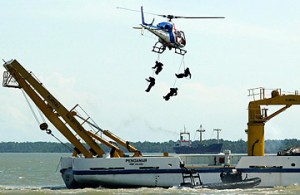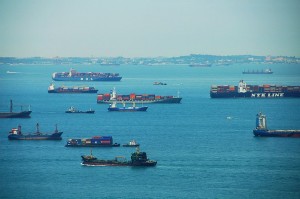By Daniel Grant
 Australia’s Abbott government has promised to write a new Defence White Paper within 18 months, and one of the key challenges it will face is considering the place of Indonesia in Australian defence thinking. As the fear of a direct Indonesian threat retreats into the past, it is being replaced by a view of Indonesia as a potential ‘buffer’ separating Australia from the vagaries of the East Asian system. But when the new government considers Australia’s defence options in the next century, it’d do well to remember that Indonesia gets a vote in the role it plays in defending Australia.
Australia’s Abbott government has promised to write a new Defence White Paper within 18 months, and one of the key challenges it will face is considering the place of Indonesia in Australian defence thinking. As the fear of a direct Indonesian threat retreats into the past, it is being replaced by a view of Indonesia as a potential ‘buffer’ separating Australia from the vagaries of the East Asian system. But when the new government considers Australia’s defence options in the next century, it’d do well to remember that Indonesia gets a vote in the role it plays in defending Australia.
Historically, Indonesia has comprised an important, though unclear, element in Australia’s strategic environment. When Australia looks at its neighbourhood in isolation, Indonesia’s proximity and strategic potential makes it appear as a liability. But if the lens is widened to encompass the entire Asia-Pacific strategic system, a strong Indonesia looks more like an asset. During the Cold War Australia’s security concerns about Indonesia revolved around threats associated with Konfrontasi, communism and state collapse, with the prospect of a nuclear-armed Sukarno regime menacing briefly in 1965. But as early as the 1970s, Defence was also conducting studies of possible regional contingencies which involved Indonesia as an ally in achieving regional security. So recognition of our mutual strategic interests coexisted with security concerns about Indonesia.
In a recent Security Challenges article Stephan Fruehling argued that the 2013 Defence White Paper is Australia’s first ‘post-Indonesia’ strategic guidance document since the 1950s. By that he means that the document doesn’t even mention the possibility that relations between Australia and Indonesia might worsen, let alone gesture towards the ‘Indonesia threat’ of yore. Instead, it casts a pretty firm vote in favour of the ‘Indonesia as asset’ conception. This shift reflects not only Australia’s growing comfort with Indonesia as a neighbour, but also the prevailing uncertainty of the Asia-Pacific strategic environment and the attendant need for Australia to build partnerships in the region.
But Australians should be careful not to read this increasingly rosy picture of Indonesia’s strategic significance as a linear trend. While a stable Indonesia acts as a buffer regardless of its policy preferences, assisting it to play the role that we may need it to requires policy coordination. An effective joint response to contingencies involving regional defence against a hostile major power, for instance, requires planning premised on a shared view of Asia’s major power politics. Despite the shifts that have taken place in the bilateral relationship, a convergence of strategic perceptions at this level hasn’t happened, and is unlikely to happen in the near future. There are several reasons for this.
While Indonesia has warmed to the US security presence in Asia, in part because it helps to restrain China, it has also been careful to keep its distance from the US out of regard for China. As Indonesian defence thinkers look out at their archipelago from Java, a complex risk environment stares back at them. While a potentially hostile China is an important risk to be mitigated, overtly pushing against China heightens many other serious risks, not the least of which being major power war. Doing so would sacrifice Indonesia’s development goals for little net security gain.
The main thrust of Indonesian statecraft has been to exert diplomatic influence in regional forums to short-circuit adversarial strategic trends and develop mechanisms to moderate conflict. This approach has been sustained through a period when China’s maritime activism reached a crescendo, America was at its most engaged in decades, and Indonesia itself had its most pro-Western President ever. Because it’s in keeping with Indonesia’s non-alignment tradition, this approach has the critical buttress of domestic support. More importantly, it remains Indonesia’s most viable strategy.
The sense of vulnerability that comes from their geographic location makes Indonesians wary of becoming entangled in the strategic calculations of foreign powers. Australia’s appreciation of Indonesia as a ‘buffer’ is a case in point: the difference between ‘buffer’ and ‘battleground’ is one of abstraction. As disastrous as major power confrontation would be for Australia, for Indonesia the fighting would take place on its doorstep, if not in its living room. This means that Australia might more readily take actions which risk escalation, especially if it feels shielded from the worst of the consequences. Deepening defence cooperation with the likes of Australia is not without its risks for Indonesia.
The next defence white paper will surely assign Indonesia an important place. But Australia should consider the possibility that we’ve already seen the full extent of Indonesia’s ‘Westward’ shift. Indonesia remains a country that pursues regional security through diplomatic means, and in this sense remains aloof from the great power game in Asia. By implicitly or explicitly assigning Indonesia a role it’s unwilling to play, we’d be putting Australia’s defence policy on unstable foundations. It’s the job of the next white paper to chart a course that Australia and Indonesia can both stick to if the seas get rough.
Daniel Grant is the 2013 Robert O’Neill Scholar at the Strategic and Defence Studies Centre at the Australian National University. This article originally appeared on the Australian Strategic Policy Institute’s blog The Strategist.





